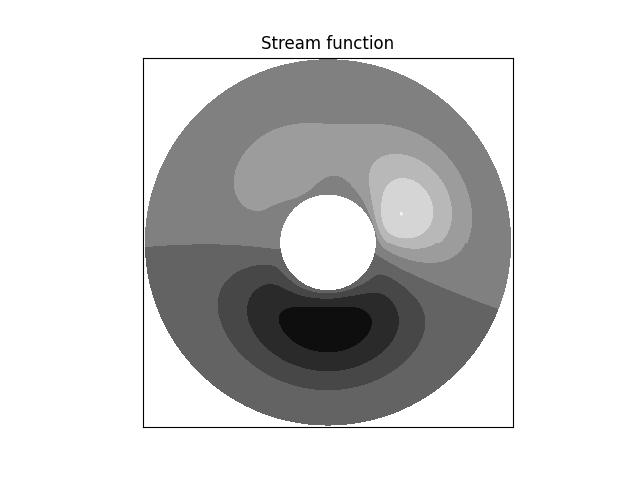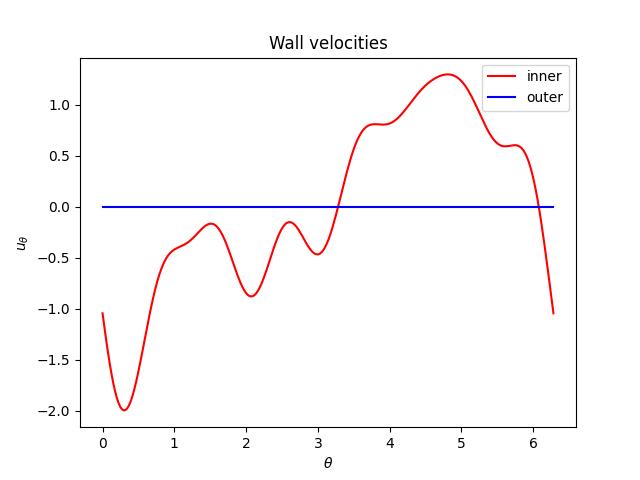Polar coordinates
The biharmonic equation in polar coordinates is written explicitly as:
\[\newcommand{\vx}{r}
\newcommand{\vy}{\theta}
\newcommand{\lx}{L_{\vx}}
\newcommand{\ly}{L_{\vy}}
\newcommand{\ux}{u_{\vx}}
\newcommand{\uy}{u_{\vy}}
\frac{1}{\vx}
\pder{}{}{\vx}
\left(
\vx
\pder{}{}{\vx}
\left(
\frac{1}{\vx}
\pder{}{}{\vx}
\left(
\vx
\pder{}{\psi}{\vx}
\right)
\right)
\right)
+
2
\frac{1}{\vx}
\pder{}{}{\vy}
\left(
\frac{1}{\vx}
\pder{}{}{\vy}
\left(
\pder{}{}{\vx}
\pder{}{\psi}{\vx}
\right)
\right)
+
\frac{1}{\vx}
\pder{}{}{\vy}
\left(
\frac{1}{\vx}
\pder{}{}{\vy}
\left(
\frac{1}{\vx}
\pder{}{}{\vy}
\left(
\frac{1}{\vx}
\pder{}{\psi}{\vy}
\right)
\right)
\right)
-
2
\frac{1}{\vx}
\frac{1}{\vx}
\pder{}{}{\vy}
\left(
\frac{1}{\vx}
\pder{}{}{\vy}
\pder{}{\psi}{\vx}
\right)
+
4
\frac{1}{\vx}
\frac{1}{\vx}
\frac{1}{\vx}
\pder{}{}{\vy}
\left(
\frac{1}{\vx}
\pder{}{\psi}{\vy}
\right)
=
0.\]
We adopt a Fourier series to expand the stream function in the azimuthal direction which is periodic:
\[\psi \left( \vx, \vy \right)
=
\sum_k \Psi_k \left( \vx \right) \expp{I k \vy}.\]
Since the azimuthal derivatives are exchangeable with the rest of the operators, we obtain
\[\sum_k
\left[
\frac{1}{\vx}
\der{}{}{\vx}
\left(
\vx
\der{}{}{\vx}
\left(
\frac{1}{\vx}
\der{}{}{\vx}
\left(
\vx
\der{}{\Psi_k}{\vx}
\right)
\right)
\right)
-
\frac{
2
k^2
}{
\vx^2
}
\der{}{}{\vx}
\der{}{\Psi_k}{\vx}
+
\frac{
2
k^2
}{
\vx^3
}
\der{}{\Psi_k}{\vx}
+
\frac{
k^4 - 4 k^2
}{
\vx^4
}
\Psi_k
\right]
\expp{I k \vy}
=
0,\]
or
\[\frac{1}{\vx}
\der{}{}{\vx}
\left(
\vx
\der{}{}{\vx}
\left(
\frac{1}{\vx}
\der{}{}{\vx}
\left(
\vx
\der{}{\Psi_k}{\vx}
\right)
\right)
\right)
-
\frac{
2
k^2
}{
\vx^2
}
\der{}{}{\vx}
\der{}{\Psi_k}{\vx}
+
\frac{
2
k^2
}{
\vx^3
}
\der{}{\Psi_k}{\vx}
+
\frac{
k^4 - 4 k^2
}{
\vx^4
}
\Psi_k
=
0\]
due to the orthogonality of the trigonometric functions.
Note that this can be written differently:
\[\vx^4
\der{4}{\Psi_k}{\vx}
+
2 \vx^3
\der{3}{\Psi_k}{\vx}
-
\left( 2 k^2 + 1 \right) \vx^2
\der{2}{\Psi_k}{\vx}
+
\left( 2 k^2 + 1 \right) \vx
\der{}{\Psi_k}{\vx}
+
\left( k^4 - 4 k^2 \right)
\Psi_k
=
0.\]
Here we perform a change-of-variable following Wood and Porter, J. Appl. Eng. Math. (6), 2019:
\[\vx = \expp{s}.\]
By using
\[\der{}{}{\vx}
=
\expp{-s} \der{}{}{s},\]
we notice
\[ \begin{align}\begin{aligned}\vx \der{}{}{\vx}
&
=
\der{}{}{s},\\\vx^2 \der{2}{}{\vx}
&
=
\der{2}{}{s}
-
\der{}{}{s},\\\vx^3
\der{3}{}{\vx}
&
=
\der{3}{}{s}
-
3
\der{2}{}{s}
+
2
\der{}{}{s},\\\vx^4
\der{4}{}{\vx}
&
=
\der{4}{}{s}
-
6
\der{3}{}{s}
+
11
\der{2}{}{s}
-
6
\der{}{}{s},\end{aligned}\end{align} \]
and thus we obtain
\[\der{4}{\Psi_k}{s}
-
4
\der{3}{\Psi_k}{s}
+
\left(
- 2 k^2
+
4
\right)
\der{2}{\Psi_k}{s}
+
4 k^2
\der{}{\Psi_k}{s}
+
\left(
k^4
-
4 k^2
\right)
\Psi_k
=
0,\]
whose characteristic equation is
\[ \begin{align}\begin{aligned}&
\lambda^4
-
4
\lambda^3
+
\left(
- 2 k^2
+
4
\right)
\lambda^2
+
4 k^2
\lambda
+
\left(
k^4
-
4 k^2
\right)\\=
&
\left(
\lambda^2 - k^2
\right)
\left[
\left( \lambda - 2 \right)^2
-
k^2
\right]\\=
&
0,\end{aligned}\end{align} \]
whose four roots are \(\lambda = \pm k, 2 \pm k\).
At \(k = 0\), we have \(\lambda = 0, 0, 2, 2\) (two multiple roots) and
\[ \begin{align}\begin{aligned}\Psi_0
&
=
\left( A_0 + B_0 s \right)
+
\left( C_0 + D_0 s \right) \expp{2 s}\\&
=
A_0
+
B_0 \log \vx
+
C_0 \vx^2
+
D_0 \vx^2 \log \vx.\end{aligned}\end{align} \]
At \(k = \pm 1\), we have \(\lambda = - 1, 1, 1, 3\) (one multiple root) and thus
\[ \begin{align}\begin{aligned}\Psi_1
&
=
A_1 \expp{- s}
+
\left( B_1 + C_1 s \right) \expp{s}
+
D_1 \expp{3 s}\\&
=
A_1 \vx^{-1}
+
B_1 \vx
+
C_1 \vx \log \vx
+
D_1 \vx^3.\end{aligned}\end{align} \]
For the other \(k\) which is not \(0\) nor \(\pm 1\), we have \(\lambda = \pm k, 2 \pm k\) (no multiple roots) and thus
\[ \begin{align}\begin{aligned}\Psi_k
&
=
A_k \expp{- k s}
+
B_k \expp{+ k s}
+
C_k \expp{\left( 2 - k \right) s}
+
D_k \expp{\left( 2 + k \right) s}\\&
=
A_k \vx^{-k}
+
B_k \vx^k
+
C_k \vx^{2 - k}
+
D_k \vx^{2 + k}.\end{aligned}\end{align} \]
To summarize, the general solution leads to
\[\begin{split}\Psi_k
=
\begin{cases}
k = 0
&
E
+
F \log \vx
+
G \vx^2
+
H \vx^2 \log \vx, \\
k = \pm 1
&
I \vx^{-1}
+
J \vx
+
K \vx \log \vx
+
L \vx^3, \\
\text{otherwise}
&
A_k \vx^{-k}
+
B_k \vx^k
+
C_k \vx^{2 - k}
+
D_k \vx^{2 + k}.
\end{cases}\end{split}\]
The wall-normal derivative is
\[\begin{split}\der{}{\Psi_k}{\vx}
=
\begin{cases}
k = 0
&
F \vx^{-1}
+
2 G \vx
+
H \left( 2 \vx \log \vx + \vx \right), \\
k = \pm 1
&
-
I \vx^{-2}
+
J
+
K \left( \log \vx + 1 \right)
+
3 L \vx^2, \\
\text{otherwise}
&
A_k \left( - k \right) \vx^{- k - 1}
+
B_k k \vx^{k - 1}
+
C_k \left( 2 - k \right) \vx^{1 - k}
+
D_k \left( 2 + k \right) \vx^{1 + k}.
\end{cases}\end{split}\]
The coefficients are determined by incorporating the boundary conditions imposed on the walls; namely, at \(\vx = \vx_i > 0\) and \(\vx = \vx_o > \vx_i\), we enforce
\[ \begin{align}\begin{aligned}\ux
&
=
\frac{1}{\vx} \pder{}{\psi}{\vy}
=
\frac{1}{\vx} \sum_k I k \Psi_k \expp{I k \vy}
=
0,\\\uy
&
=
-
\pder{}{\psi}{\vx}
=
-
\sum_k \der{}{\Psi_k}{\vx} \expp{I k \vy}
=
f_{\vx_i, \vx_o} \left( \vy \right),\end{aligned}\end{align} \]
which are, by performing forward transform:
\[I k \Psi_k
=
0,\]
\[\der{}{\Psi_k}{\vx}
=
-
\int
f_{\vx_i, \vx_o} \left( \vy \right)
\expp{- I k \vy}
d \vy.\]
The implementation is as follows.
def compute_stream_function(xs: np.ndarray, ys: np.ndarray, bc: [np.ndarray, np.ndarray]) -> np.ndarray:
# convert wall velocities to frequency domain
uy_m = - np.fft.rfft(bc[0])
uy_p = - np.fft.rfft(bc[1])
# compute stream function in frequency domain
psi_freq = np.zeros((ny // 2 + 1, nx), dtype="complex128")
mat = np.zeros((4, 4), dtype="float64")
vec = np.zeros((4), dtype="complex128")
# zero-th mode cannot be determined: just assign zero
psi_freq[0, :] = 0
for k in range(1, ny // 2 + 1):
# for each wavenumber, compute coefficients
mat[0] = get_f(k, xlim[0])
mat[1] = get_f(k, xlim[1])
mat[2] = get_dfdx(k, xlim[0])
mat[3] = get_dfdx(k, xlim[1])
vec[0] = 0
vec[1] = 0
vec[2] = uy_m[k]
vec[3] = uy_p[k]
coefs = np.linalg.solve(mat, vec)
# for each wall-normal position, compute stream function
for i, x in enumerate(xs):
psi_freq[k, i] = np.dot(coefs, get_f(k, x))
# convert frequency domain to physical domain
psi = np.zeros((ny, nx), dtype="float64")
for i, x in enumerate(xs):
psi[:, i] = np.fft.irfft(psi_freq[:, i])
return psi
def compute_boundary_condition(ys: np.ndarray) -> [np.ndarray, np.ndarray]:
uy_m = np.zeros(ys.shape)
uy_p = np.zeros(ys.shape)
for k in range(1, 8):
amp = np.power(float(k), -1)
phase = 2 * np.pi * np.random.random_sample()
uy_m += amp * np.sin(k * ys + phase)
return uy_m, uy_p
def get_f(k: int, x: float) -> float:
if 0 == k:
raise RuntimeError("This code should not be reachable")
elif 1 == k:
return [
np.power(x, -1),
x,
x * np.log(x),
np.power(x, 3),
]
else:
return [
np.power(x, 0 - k),
np.power(x, 0 + k),
np.power(x, 2 - k),
np.power(x, 2 + k),
]
def get_dfdx(k: int, x: float) -> float:
if 0 == k:
raise RuntimeError("This code should not be reachable")
elif 1 == k:
return [
- np.power(x, -2),
1,
np.log(x) + 1,
3 * np.power(x, 2),
]
else:
return [
(0 - k) * np.power(x, 0 - k - 1),
(0 + k) * np.power(x, 0 + k - 1),
(2 - k) * np.power(x, 2 - k - 1),
(2 + k) * np.power(x, 2 + k - 1),
]
The results are displayed below.



